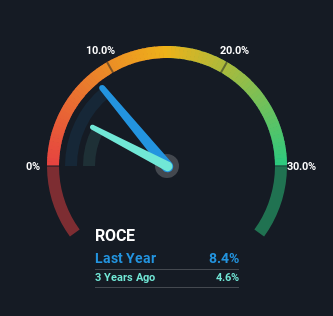- India
- /
- Food and Staples Retail
- /
- NSEI:SAKUMA
Here's What's Concerning About Sakuma Exports' (NSE:SAKUMA) Returns On Capital
There are a few key trends to look for if we want to identify the next multi-bagger. Typically, we'll want to notice a trend of growing return on capital employed (ROCE) and alongside that, an expanding base of capital employed. Basically this means that a company has profitable initiatives that it can continue to reinvest in, which is a trait of a compounding machine. However, after investigating Sakuma Exports (NSE:SAKUMA), we don't think it's current trends fit the mold of a multi-bagger.
Return On Capital Employed (ROCE): What Is It?
Just to clarify if you're unsure, ROCE is a metric for evaluating how much pre-tax income (in percentage terms) a company earns on the capital invested in its business. To calculate this metric for Sakuma Exports, this is the formula:
Return on Capital Employed = Earnings Before Interest and Tax (EBIT) ÷ (Total Assets - Current Liabilities)
0.084 = ₹376m ÷ (₹5.7b - ₹1.2b) (Based on the trailing twelve months to March 2023).
So, Sakuma Exports has an ROCE of 8.4%. On its own that's a low return, but compared to the average of 5.4% generated by the Consumer Retailing industry, it's much better.
See our latest analysis for Sakuma Exports

Historical performance is a great place to start when researching a stock so above you can see the gauge for Sakuma Exports' ROCE against it's prior returns. If you want to delve into the historical earnings, revenue and cash flow of Sakuma Exports, check out these free graphs here.
How Are Returns Trending?
When we looked at the ROCE trend at Sakuma Exports, we didn't gain much confidence. Over the last five years, returns on capital have decreased to 8.4% from 25% five years ago. Although, given both revenue and the amount of assets employed in the business have increased, it could suggest the company is investing in growth, and the extra capital has led to a short-term reduction in ROCE. If these investments prove successful, this can bode very well for long term stock performance.
On a related note, Sakuma Exports has decreased its current liabilities to 22% of total assets. So we could link some of this to the decrease in ROCE. What's more, this can reduce some aspects of risk to the business because now the company's suppliers or short-term creditors are funding less of its operations. Since the business is basically funding more of its operations with it's own money, you could argue this has made the business less efficient at generating ROCE.
What We Can Learn From Sakuma Exports' ROCE
While returns have fallen for Sakuma Exports in recent times, we're encouraged to see that sales are growing and that the business is reinvesting in its operations. These trends don't appear to have influenced returns though, because the total return from the stock has been mostly flat over the last five years. So we think it'd be worthwhile to look further into this stock given the trends look encouraging.
If you want to know some of the risks facing Sakuma Exports we've found 2 warning signs (1 is a bit unpleasant!) that you should be aware of before investing here.
While Sakuma Exports isn't earning the highest return, check out this free list of companies that are earning high returns on equity with solid balance sheets.
New: Manage All Your Stock Portfolios in One Place
We've created the ultimate portfolio companion for stock investors, and it's free.
• Connect an unlimited number of Portfolios and see your total in one currency
• Be alerted to new Warning Signs or Risks via email or mobile
• Track the Fair Value of your stocks
Have feedback on this article? Concerned about the content? Get in touch with us directly. Alternatively, email editorial-team (at) simplywallst.com.
This article by Simply Wall St is general in nature. We provide commentary based on historical data and analyst forecasts only using an unbiased methodology and our articles are not intended to be financial advice. It does not constitute a recommendation to buy or sell any stock, and does not take account of your objectives, or your financial situation. We aim to bring you long-term focused analysis driven by fundamental data. Note that our analysis may not factor in the latest price-sensitive company announcements or qualitative material. Simply Wall St has no position in any stocks mentioned.
About NSEI:SAKUMA
Mediocre balance sheet with questionable track record.
Similar Companies
Market Insights
Community Narratives




